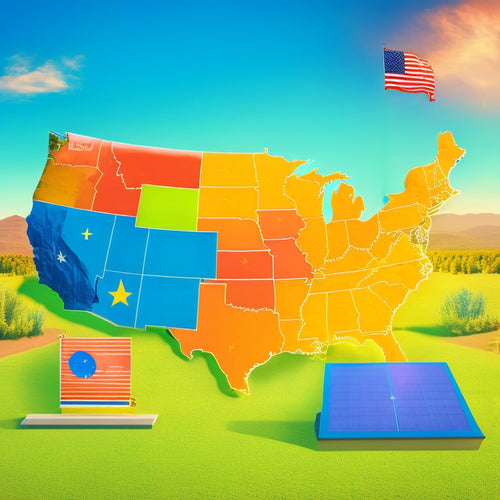
Top Solar Panels for Scorching Hot Climates
Share
When selecting solar panels for scorching hot climates, you need high-efficiency panels that can withstand extreme temperatures without compromising energy output. Look for panels with low thermal expansion coefficients, heat sinks, and heat-resistant materials like anodized aluminum frames and tempered glass. Top brands like Trina Solar, JA Solar, and Hanwha Q CELLS offer heat-tested panels that can endure temperatures up to 90°C. High-efficiency models with efficiency ratings above 20% reduce maintenance needs and provide higher energy output. To guarantee maximum performance in scorching heat, explore the best options for your specific climate and energy needs next.
Key Takeaways
• High-efficiency solar panels with low thermal expansion coefficients are ideal for scorching hot climates to maintain efficiency.
• Heat sinks made of materials like aluminum can improve panel lifespan and energy output by dissipating heat effectively.
• Look for durable panels with heat-resistant materials like anodized aluminum frames and tempered glass to ensure longevity.
• Top brands like Trina Solar, JA Solar, and Hanwha Q CELLS offer heat-resistant panels tested for extreme temperatures up to 90°C.
• High-efficiency models with advanced technology can maximize energy yield from intense sunlight, reducing maintenance needs.
High-Efficiency Solar Panels for Heat
When operating in scorching hot climates, you need high-efficiency solar panels that can withstand extreme temperatures while maintaining peak energy production. You wouldn't want your solar panels to sizzle like a hot dog on the 4th of July, right? That's where thermal expansion comes in – an essential factor to take into account when selecting the right solar panels for hot climates. Thermal expansion occurs when materials expand due to heat, which can cause mechanical stress and reduce panel efficiency. Look for solar panels with a low coefficient of thermal expansion to minimize this effect.
Another vital aspect is heat sinks, which are designed to dissipate heat away from the panel. Think of them as the solar panel's personal air conditioner! Heat sinks are usually made of materials with high thermal conductivity, such as aluminum or copper. By incorporating heat sinks into the panel design, manufacturers can reduce operating temperatures, increasing energy output and overall panel lifespan.
Durable Panels With Heat Resistance
Choose solar panels with durable heat-resistant materials, such as anodized aluminum frames or tempered glass, to guarantee your system withstands the scorching heat and maintains its performance over time. You'll be thanking yourself when your panels continue to churn out energy like a well-oiled machine, even in the blistering heat.
When it comes to panel longevity, heat shielding is key. Look for panels with built-in heat shielding technology that prevents overheating, which can reduce your system's efficiency. You want your panels to last for years to come, not fizzle out after a few summers.
Top Brands for Hot Climates Only
Your search for top-tier solar panels tailored to scorching hot climates leads you to brands that have perfected the art of heat-resistant technology. When it comes to climate testing, only a handful of brands can claim to have undergone rigorous testing in extreme temperatures.
Here are some top brands that have aced the heat test:
-
Trina Solar: Known for their heat-resistant modules, Trina Solar's panels have been tested in temperatures up to 85°C (185°F).
-
JA Solar: This Chinese brand has perfected the art of heat-resistant technology, with panels that can withstand temperatures up to 90°C (194°F).
-
Hanwha Q CELLS: With a strong focus on climate testing, Hanwha Q CELLS' panels have been put through their paces in temperatures ranging from -40°C to 85°C (-40°F to 185°F).
- Mitsubishi Electric: This Japanese brand has developed advanced heat-resistant materials, allowing their panels to perform flawlessly even in extreme temperatures.
When it comes to brand comparison, these top brands stand out for their commitment to climate testing and heat-resistant technology. By choosing one of these brands, you can rest assured that your solar panels will perform flawlessly even in the hottest climates.
Solar Panels With Maximum Output
You'll want solar panels that can harness the maximum amount of energy from the scorching sun, and that's where high-efficiency models come into play. These powerhouses are designed to squeeze every last watt out of the intense sunlight, giving you a higher energy yield. When it comes to panel maintenance, high-efficiency models often require less upkeep since they're built to withstand the harsh conditions.
With a higher energy output, you'll be generating more power and reducing your reliance on the grid.
Look for panels with high-efficiency ratings, typically above 20%. These models use advanced technology to minimize heat loss and maximize energy conversion. Some top performers include the SunPower X-Series, Panasonic HIT-240, and the LG NeON 2. These panels boast impressive efficiency ratings, with some reaching as high as 22.8%!
With scorching heat and intense sunlight, you need panels that can keep up. High-efficiency models are the way to go, providing you with a higher energy yield and less maintenance worries.
Heat-Tolerant Panels for Residential Use
Heat-tolerant solar panels are specifically designed for residential use, incorporating advanced materials and technologies to mitigate the negative effects of high temperatures on energy production. As a homeowner, you understand the importance of maximizing energy output, especially in scorching hot climates. Heat-tolerant panels are engineered to thrive in these conditions, ensuring you reap the benefits of renewable energy.
Here are some key advantages of heat-tolerant panels for residential use:
-
Climate Control: These panels are built to withstand extreme temperatures, ensuring consistent energy production regardless of the climate.
-
Homeowner Benefits: By investing in heat-tolerant panels, you'll enjoy increased energy savings, reduced carbon footprint, and a potential boost in property value.
-
Enhanced Efficiency: Advanced materials and technologies used in heat-tolerant panels minimize energy losses, maximizing your energy output.
- Durability: These panels are built to last, withstanding the harsh conditions of scorching hot climates while maintaining their performance over time.
Best Value for Scorching Hot Areas
When selecting solar panels for scorching hot areas, you're likely looking for the best value without compromising performance. High-efficiency modules can provide you with more power per hour of sunlight, making them an attractive option.
High-Efficiency Modules
In scorching hot climates, high-efficiency modules offer the best value by maximizing energy production while minimizing heat-related losses. When the sun beats down on your solar panels, you want to make certain you're getting the most bang for your buck. High-efficiency modules are designed to do just that. They're engineered to minimize energy losses, which can be a major issue in hot climates.
You see, when solar panels get too hot, they start to lose efficiency - it's like trying to run a marathon in the desert without water. Not ideal.
Here are some key benefits of high-efficiency modules:
** They reduce energy losses by up to 20% compared to standard modules
** They're designed with advanced cooling systems to keep temperatures in check
-
They're built with high-quality materials that can withstand extreme heat
-
They provide more power per hour of sunlight, so you get more bang for your buck
Heat-Resistant Materials Used
You'll want to look for solar panels constructed with heat-resistant materials, such as tempered glass or anodized aluminum frames, which can withstand scorching temperatures without compromising performance. These materials are essential in hot climates, where temperatures can soar above 100°F (38°C).
Thermal coatings can also be applied to reduce heat absorption, keeping your panels running cool and efficiently. Advanced ceramics, like silicon carbide, are another excellent option for withstanding extreme temperatures. These materials have high thermal conductivity, allowing heat to dissipate quickly, and are also incredibly durable.
When shopping for solar panels, look for certifications like UL 1703, which guarantees the panel can operate safely in high-temperature environments. Additionally, check the manufacturer's temperature coefficient rating, which indicates how well the panel performs in hot temperatures.
Frequently Asked Questions
Can I Install Solar Panels on a Metal Roof in a Hot Climate?
You can install solar panels on a metal roof in a hot climate, but make sure the panels are compatible with metal and consider the roof temperature, which can soar up to 150°F, affecting panel efficiency.
How Often Should I Clean Solar Panels in Dusty Desert Environments?
'You'll want to clean your solar panels every 2-4 weeks in dusty desert environments to prevent energy-sapping dust accumulation. Stick to a regular cleaning schedule to guarantee peak performance and maximize energy output, sans dusty drama.'
Are Solar Panels With Built-In Inverters Suitable for Hot Climates?
When you're shopping for solar panels with built-in inverters, you should prioritize Microclimate Analysis to guarantee peak performance. In hot climates, look for high Thermal Efficiency to prevent overheating, and consider models with advanced cooling systems to keep things chill.
Can I Use Solar Panels With a Warranty That Doesn't Cover Heat Damage?
You're wondering if you can use solar panels with a warranty that doesn't cover heat damage? Be cautious, as heat exposure can wreak havoc; always check warranty limitations before investing, or you might be left feeling burned.
Do Solar Panels Perform Better in Hot Climates With Trackers or Fixed Mounts?
When you're deciding between trackers and fixed mounts in hot climates, consider heat resistance and temperature coefficients. Trackers help minimize heat damage, but fixed mounts can be more cost-effective, so weigh your options carefully.
Related Posts
-

Top 10 Tips for Buying Car Accessories Online
When purchasing car accessories online, you should take proactive steps to avoid low-quality or incompatible products...
-

10 Best Solar Panel Options for Motorhomes Online
When choosing the best solar panel for your motorhome, consider factors like efficiency, durability, and design. You'...
-

3 Best State and Local Solar Incentives USA
You can greatly reduce your energy dependence and save thousands of dollars by taking advantage of the top state and ...


